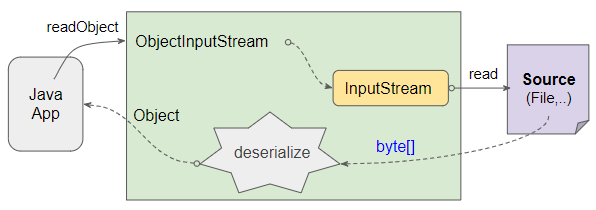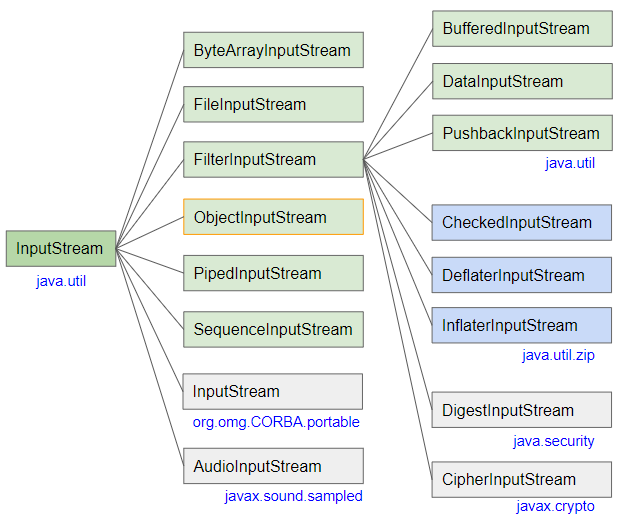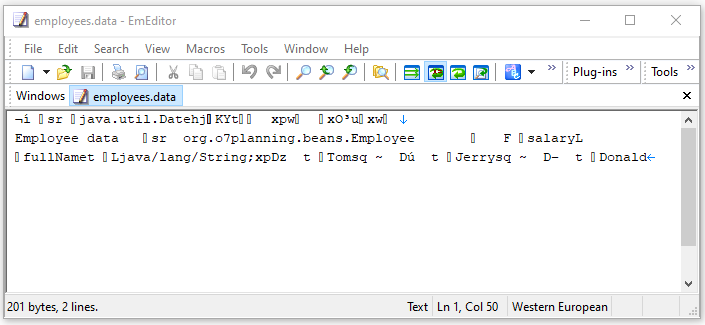Die Anleitung zu Java ObjectInputStream
1. ObjectInputStream
ObjectInputStream ist eine Unterklasse der Klasse InputStream. Es verwaltet ein Objekt InputStream und stellt die Methode bereit um die primitiven Daten oder das Objekt aus dem von ihr verwalteten InputStream zu lesen.

public class ObjectInputStream
extends InputStream implements ObjectInput, ObjectStreamConstantsObjectInputStream wird zum Lesen der von ObjectOutputStream geschriebenen Datenquellen verwendet.

- InputStream
- FileInputStream
- ByteArrayInputStream
- PushbackInputStream
- PipedInputStream
- SequenceInputStream
- BufferedInputStream
- DataInputStream
- FilterInputStream
- AudioInputStream
- InflaterInputStream
- DigestInputStream
- DeflaterInputStream
- CipherInputStream
- CheckedInputStream
ObjectInputStream methods
public boolean readBoolean() throws IOException
public byte readByte() throws IOException
public int readUnsignedByte() throws IOException
public char readChar() throws IOException
public short readShort() throws IOException
public int readUnsignedShort() throws IOException
public int readInt() throws IOException
public long readLong() throws IOException
public float readFloat() throws IOException
public double readDouble() throws IOException
public void readFully(byte[] buf) throws IOException
public void readFully(byte[] buf, int off, int len) throws IOException
public int skipBytes(int len) throws IOException
public String readUTF() throws IOException
public final ObjectInputFilter getObjectInputFilter()
public final void setObjectInputFilter(ObjectInputFilter filter)
public final Object readObject() throws IOException, ClassNotFoundException
public Object readUnshared() throws IOException, ClassNotFoundException
public void defaultReadObject() throws IOException, ClassNotFoundException
public ObjectInputStream.GetField readFields() throws IOException, ClassNotFoundException
public void registerValidation(ObjectInputValidation obj, int prio) throws NotActiveException, InvalidObjectException
protected Class<?> resolveClass(ObjectStreamClass desc) throws IOException, ClassNotFoundException
protected Object readObjectOverride() throws IOException, ClassNotFoundException
protected Class<?> resolveProxyClass(String[] interfaces) throws IOException, ClassNotFoundException
protected Object resolveObject(Object obj) throws IOException
protected boolean enableResolveObject(boolean enable) throws SecurityException
protected void readStreamHeader() throws IOException, StreamCorruptedException
protected ObjectStreamClass readClassDescriptor() throws IOException, ClassNotFoundException
String readTypeString() throws IOException
// Methods inherited from InputStream:
public int read() throws IOException
public int read(byte[] buf, int off, int len) throws IOException
public int available() throws IOException
public void close() throws IOExceptionObjectInputStream constructors
public ObjectInputStream(InputStream in)2. Example 1
In diesem Beispiel schreiben wir die Objekte Employee in einer Datei, und verwenden dann ObjectInputStream um die Datei zu lesen.
Die Klasse Employee muss eine serialisierbare Interface Serializable implementieren, die erforderlich ist, damit sie in einen ObjectOutputStream geschrieben werden kann.
Employee.java
package org.o7planning.beans;
import java.io.Serializable;
public class Employee implements Serializable {
private static final long serialVersionUID = 1L;
private String fullName;
private float salary;
public Employee(String fullName, float salary) {
this.fullName = fullName;
this.salary = salary;
}
public String getFullName() {
return fullName;
}
public void setFullName(String firstName) {
this.fullName = firstName;
}
public float getSalary() {
return salary;
}
public void setSalary(float lastName) {
this.salary = lastName;
}
}Verwenden Sie zum Nächsten ObjectOutputStream um die Objekte Employee in die Datei zu schreiben.
WriteEmployeeDataEx.java
package org.o7planning.objectinputstream.ex;
import java.io.File;
import java.io.FileOutputStream;
import java.io.IOException;
import java.io.ObjectOutputStream;
import java.io.OutputStream;
import java.util.Date;
import org.o7planning.beans.Employee;
public class WriteEmployeeDataEx {
// Windows: C:/Data/test/employees.data
private static String file_path = "/Volumes/Data/test/employees.data";
public static void main(String[] args) throws IOException {
File outFile = new File(file_path);
outFile.getParentFile().mkdirs();
Employee e1 = new Employee("Tom", 1000f);
Employee e2 = new Employee("Jerry", 2000f);
Employee e3 = new Employee("Donald", 1200f);
Employee[] employees = new Employee[] { e1, e2, e3 };
OutputStream os = new FileOutputStream(outFile);
ObjectOutputStream oos = new ObjectOutputStream(os);
System.out.println("Writing file: " + outFile.getAbsolutePath());
oos.writeObject(new Date());
oos.writeUTF("Employee data"); // Some informations.
oos.writeInt(employees.length); // Number of Employees
for (Employee e : employees) {
oos.writeObject(e);
}
oos.close();
System.out.println("Finished!");
}
}Nach dem Ausführen der Klasse WriteEmployeeDataEx erhalten wir eine Datei mit verwirrendem Inhalt

Zum Letzten verwenden wir ObjectInputStream um die gerade im vorherigen Schritt geschriebene Datei zu lesen.
ReadEmployeeDataEx.java
package org.o7planning.objectinputstream.ex;
import java.io.File;
import java.io.FileInputStream;
import java.io.IOException;
import java.io.InputStream;
import java.io.ObjectInputStream;
import java.util.Date;
import org.o7planning.beans.Employee;
public class ReadEmployeeDataEx {
// Windows: C:/Data/test/employees.data
private static String file_path = "/Volumes/Data/test/employees.data";
public static void main(String[] args) throws IOException, ClassNotFoundException {
File inFile = new File(file_path);
InputStream is = new FileInputStream(inFile);
ObjectInputStream ois = new ObjectInputStream(is);
System.out.println("Reading file: " + inFile.getAbsolutePath());
System.out.println();
Date date = (Date) ois.readObject();
String info = ois.readUTF();
System.out.println(date);
System.out.println(info);
System.out.println();
int employeeCount = ois.readInt();
for(int i=0; i< employeeCount; i++) {
Employee e = (Employee) ois.readObject();
System.out.println("Employee Name: " + e.getFullName() +" / Salary: " + e.getSalary());
}
ois.close();
}
}Output:
Reading file: /Volumes/Data/test/employees.data
Sat Mar 20 18:54:24 KGT 2021
Employee data
Employee Name: Tom / Salary: 1000.0
Employee Name: Jerry / Salary: 2000.0
Employee Name: Donald / Salary: 1200.03. readFields()
Angenommen, Sie verwenden ObjectInputStream um ein Objekt GameSetting aus einer Datei zu lesen. Gleichzeitig möchten Sie beim Lesen des Objekt GameSetting die Werte einiger Felder ändern.
GameSetting.java
package org.o7planning.beans;
import java.io.IOException;
import java.io.ObjectInputStream;
public class GameSetting implements java.io.Serializable {
private static final long serialVersionUID = 1L;
private int sound;
private int bightness;
private String difficultyLevel;
private String userNote;
public GameSetting(int sound, int bightness, String difficultyLevel, String userNote) {
this.sound = sound;
this.bightness = bightness;
this.difficultyLevel = difficultyLevel;
this.userNote = userNote;
}
public int getSound() {
return sound;
}
public int getBightness() {
return bightness;
}
public String getDifficultyLevel() {
return difficultyLevel;
}
public String getUserNote() {
return userNote;
}
// Do not change name and parameter of this method.
private void readObject(ObjectInputStream in) throws IOException, ClassNotFoundException {
ObjectInputStream.GetField fields = in.readFields();
this.sound = fields.get("sound", 50);
this.bightness = fields.get("bightness", 50);
// Edit fields
this.difficultyLevel = (String) fields.get("difficultyLevel", "Easy"); // Default
if (this.difficultyLevel == null) {
this.difficultyLevel = "Easy";
}
this.userNote = (String) fields.get("userNote", "Have fun!"); // Default
if (this.userNote == null) {
this.userNote = "Have fun!";
}
}
}ObjectInputStream_readFields.java
package org.o7planning.objectinputstream.ex;
import java.io.File;
import java.io.FileInputStream;
import java.io.FileOutputStream;
import java.io.IOException;
import java.io.InputStream;
import java.io.ObjectInputStream;
import java.io.ObjectOutputStream;
import java.io.OutputStream;
import java.util.Date;
import org.o7planning.beans.GameSetting;
public class ObjectInputStream_readFields {
// Windows: C:/Data/test/game_setting.data
private static String file_path = "/Volumes/Data/test/game_setting.data";
public static void main(String[] args) throws IOException, ClassNotFoundException {
GameSetting setting = new GameSetting(10, 80, null, null);
writeGameSetting(setting);
readGameSetting();
}
private static void writeGameSetting(GameSetting setting) throws IOException {
File file = new File(file_path);
file.getParentFile().mkdirs();
OutputStream os = new FileOutputStream(file);
ObjectOutputStream oos = new ObjectOutputStream(os);
// Write a String
oos.writeUTF("Game Settings, Save at " + new Date());
// Write Object
oos.writeObject(setting);
oos.close();
}
private static void readGameSetting() throws IOException, ClassNotFoundException {
File file = new File(file_path);
file.getParentFile().mkdirs();
InputStream is = new FileInputStream(file);
ObjectInputStream ois = new ObjectInputStream(is);
// Read a String
String info = ois.readUTF();
// Read fields
GameSetting setting = (GameSetting) ois.readObject();
System.out.println("sound: " + setting.getSound());
System.out.println("bightness: " + setting.getBightness());
System.out.println("difficultyLevel: " + setting.getDifficultyLevel());
System.out.println("userNote: " + setting.getUserNote()); // null.
ois.close();
}
}Output:
sound: 10
bightness: 80
difficultyLevel: Easy
userNote: Have fun!4. readUnshared()
Die Methode ObjectInputStream.readUnshared() wird zum Lesen eines von der Methode ObjectOutputStream.writeUnshared(Object) geschriebenen Objekt verwendet.
ObjectInputStream_readUnshared.java
package org.o7planning.objectinputstream.ex;
import java.io.File;
import java.io.FileInputStream;
import java.io.FileOutputStream;
import java.io.IOException;
import java.io.InputStream;
import java.io.ObjectInputStream;
import java.io.ObjectOutputStream;
import java.io.OutputStream;
import java.util.ArrayList;
public class ObjectInputStream_readUnshared {
// Windows: C:/Data/test/test1.data
private static String file_path = "/Volumes/Data/test/test.data";
public static void main(String[] args) throws IOException, ClassNotFoundException {
writeUnsharedTest();
readUnsharedTest();
}
private static void writeUnsharedTest() throws IOException {
File file = new File(file_path);
file.getParentFile().mkdirs();
ArrayList<String> list = new ArrayList<String>();
list.add("One");
list.add("Two");
OutputStream os = new FileOutputStream(file);
ObjectOutputStream oos = new ObjectOutputStream(os);
oos.writeUnshared(list); // Write the first time
oos.writeUnshared(list); // Write the second time
oos.close();
}
@SuppressWarnings({ "unchecked" })
private static void readUnsharedTest() throws IOException, ClassNotFoundException {
File file = new File(file_path);
ArrayList<String> list = new ArrayList<String>();
list.add("One");
list.add("Two");
InputStream is = new FileInputStream(file);
ObjectInputStream ois = new ObjectInputStream(is);
ArrayList<String> list1 = (ArrayList<String>) ois.readUnshared();
ArrayList<String> list2 = (ArrayList<String>) ois.readUnshared();
System.out.println("list1 == list2? " + (list1 == list2));
ois.close();
}
}Output:
list1 == list2? falseSehen Sie mehr die Erklärungen über die Methode ObjectOutputStream.writeUnshared(Object):
Die Anleitungen Java IO
- Die Anleitung zu Java CharArrayWriter
- Die Anleitung zu Java FilterReader
- Die Anleitung zu Java FilterWriter
- Die Anleitung zu Java PrintStream
- Die Anleitung zu Java BufferedReader
- Die Anleitung zu Java BufferedWriter
- Die Anleitung zu Java StringReader
- Die Anleitung zu Java StringWriter
- Die Anleitung zu Java PipedReader
- Die Anleitung zu Java LineNumberReader
- Die Anleitung zu Java PushbackReader
- Die Anleitung zu Java PrintWriter
- Die Anleitung zu Java IO Binary Streams
- Die Anleitung zu Java IO Character Streams
- Die Anleitung zu Java BufferedOutputStream
- Die Anleitung zu Java ByteArrayOutputStream
- Die Anleitung zu Java DataOutputStream
- Die Anleitung zu Java PipedInputStream
- Die Anleitung zu Java OutputStream
- Die Anleitung zu Java ObjectOutputStream
- Die Anleitung zu Java PushbackInputStream
- Die Anleitung zu Java SequenceInputStream
- Die Anleitung zu Java BufferedInputStream
- Die Anleitung zu Java Reader
- Die Anleitung zu Java Writer
- Die Anleitung zu Java FileReader
- Die Anleitung zu Java FileWriter
- Die Anleitung zu Java CharArrayReader
- Die Anleitung zu Java ByteArrayInputStream
- Die Anleitung zu Java DataInputStream
- Die Anleitung zu Java ObjectInputStream
- Die Anleitung zu Java InputStreamReader
- Die Anleitung zu Java OutputStreamWriter
- Die Anleitung zu Java InputStream
- Die Anleitung zu Java FileInputStream
Show More
- Anleitungen Java Servlet/JSP
- Die Anleitungen Java New IO
- Anleitungen Spring Cloud
- Die Anleitungen Oracle Java ADF
- Die Anleitungen Java Collections Framework
- Java Grundlagen
- Die Anleitungen Java Date Time
- Java Open Source Bibliotheken
- Anleitungen Java Web Services
- Die Anleitungen Struts2 Framework
- Anleitungen Spring Boot